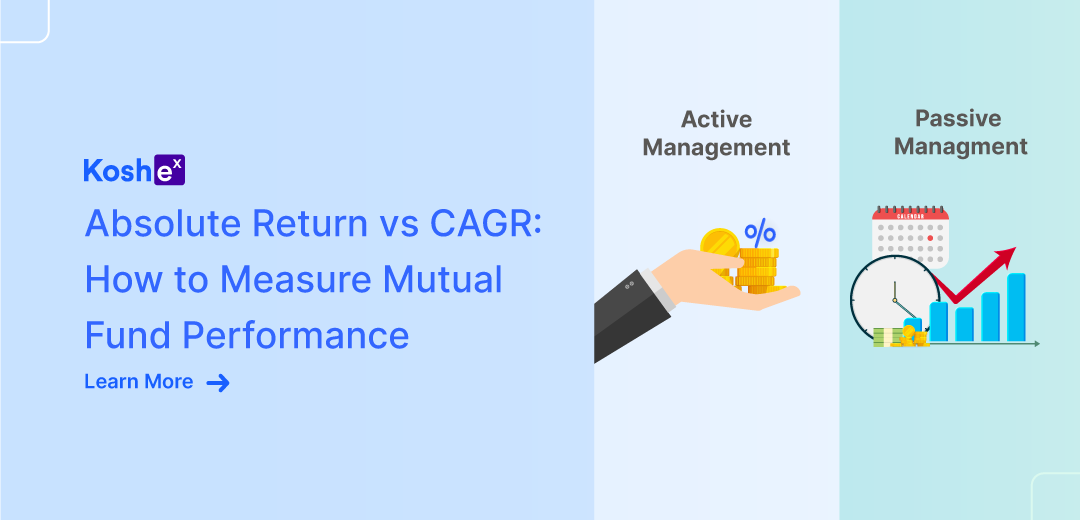Investing in mutual funds can be one of the most effective ways to grow your wealth over time. At the same time, it is important to study the important metrics used by investors, such as Absolute Return vs Compound Annual Growth Rate (CAGR). These metrics will tell you how well a mutual fund has performed over a certain period.
In this blog, we will break down the concepts of Absolute Returns vs CAGR, compare them and discuss how you can use each to measure the performance of your mutual fund investments.
What Are Absolute Returns In A Mutual Fund?
Absolute Returns in a mutual fund refer to the return from a fund over a certain period of time. It is the total return from a mutual fund from the date of investment. Absolute Returns are expressed as a percentage and measure how much your investment has grown (or shrunk) in terms of percentage.
Absolute Returns are pure returns from the investment and don’t compare to any other benchmark. Also, Absolute Returns can be positive or negative. The fund managers of mutual funds seek a positive return by using many strategies such as short selling or derivatives.
The calculation for Absolute Return is straightforward.
Absolute Return = (Current Value – Initial investment / Initial Investment) x 100
For example, if you invested ₹1 lakh in a mutual fund and after 3 years, the value of your investment is ₹1.3 lakhs, the Absolute Return is:
Absolute Return = (1,30,000 – 1,00,000 / 1,00,000) x 100 = 30%.
It shows that your investment has grown by 30%, but it doesn’t tell you how long it took for that growth to happen. Using Absolute Return alone, one cannot determine whether the investment is good or not as the tenure of the investment isn’t known.
When To Use Absolute Return?
Short-Term Investments: If you are evaluating mutual funds over a shorter period, say one year or less, Absolute Return can give you a quick snapshot of performance.
One-Time Comparisons: If you are looking at performance over a specific period for a single investment, Absolute Return is a useful tool.
However, for longer-term investments, this metric can be misleading since it doesn’t account for the compounding effect over time.
Also Read: How to Start Investing: A Guide for Beginners in 2024
What Is Compound Annual Growth Rate (CAGR) In A Mutual Fund?
CAGR or Compounded Annual Growth Rate is the rate of return from a mutual fund during a specific period of time, assuming the profits are reinvested. CAGR shows the rate at which the investment grows each year to reach the investment’s final value.
The formula for CAGR = (Final Value / Initial Investment)^1/n – 1
Where:
The Final Value is the value of your investment at the end of the period.
Initial Investment is the amount you initially invested.
n is the number of years.
Let’s use the same example. You invested ₹1 lakh and after three years, it grew to ₹1.3 lakhs.
The CAGR is calculated as:
CAGR = (1,30,000 / 1,00,000)^1/3 – 1 = 9.14%
This means that your investment grew at a compounded rate of approximately 9.14% annually over three years.
When To Use CAGR?
Long-Term Investments: CAGR is perfect for evaluating long-term mutual fund performance because it smooths out year-on-year volatility and gives you a clearer picture of the growth trajectory.
Comparing Different Investments: CAGR is ideal when comparing different mutual funds or investments over varying time periods, as it gives a normalised rate of return.
Also Read: What Is Compounding?
What Are The Differences Between Absolute Return And CAGR?
Here are the differences between Absolute Return vs CAGR.
| Aspect | Absolute Return | CAGR |
| Definition | The total percentage change in the value of an investment over a specified period, without considering the time taken. | A measure of an investment’s mean annual growth rate over a specified period, assuming the investment had compounded at that rate annually. |
| Time Sensitivity | It does not consider time; it represents the overall growth or decline. | It reflects the smoothed annualised growth rate over the investment period. |
| Interpretation | It represents the actual gain or loss over the entire investment period. | It provides a standardised measure to compare investments with different timeframes. |
| Usefulness | It provides a clear indication of an investment’s overall gain or loss without considering the time it took to achieve it. | It is useful for analysing the performance of an investment over a long period, especially for comparing investments with different timeframes. |
| Limitations | It doesn’t consider volatility within the investment period. | It doesn’t offer insights into the consistency or volatility of returns. |
Comparing Examples
Imagine you are analysing two mutual funds.
- Fund A gives you an Absolute Return of 50% over 5 years.
- Fund B gives you an Absolute Return of 30% over 3 years.
When you look at these numbers, you may think that Fund A seems to outperform Fund B.
However, if we calculate the CAGR for both these funds, we could find:
Fund A’s CAGR = (1 + 50 / 100)^(1/5) – 1 = 8.45
Fund B’s CAGR = (1 + 30 / 100)^(1/3) – 1 = 9.14
Even though Fund A has a higher Absolute Return, Fund B has grown at a faster rate annually, indicating a better long-term investment potential.
Absolute Return or CAGR – Which Metric Should You Use?
Both Absolute Return and CAGR are important metrics but they serve different purposes. Here’s when you can use each of them.
For Short-Term Investors – If you are investing for a short-term goal and want to quickly evaluate how much money you have made or lost, Absolute Return is a more straightforward measure. This can tell you how much your investment has grown in total, without worrying about how long it took.
For Long-Term Investors – If you are investing for long-term goals like retirement or wealth building, CAGR gives you a better understanding of how your investment has grown annually, and it accounts for the effect of compounding, This is especially useful when comparing the performance of multiple funds over different time frames.
For Comparing Investments – If you wish to compare multiple mutual funds over varying time horizons, you should go for CAGR. Absolute Return can be misleading if you only focus on the total return without considering how long it took to achieve that return.
Also Read: Best Investment Plans For 5 Years – How To Invest Wisely?
Limitations Of Both Metrics
While Absolute Return and CAGR are essential, they also have limitations:
Absolute Return doesn’t offer any insight into how the investment performed each year. An investment with a 30% Absolute Return might have experienced high volatility, making it a less stable investment.
CAGR assumes a steady growth rate, but in reality, mutual fund returns can be highly volatile. While it smooths out this volatility, it doesn’t show the actual year-to-year performance, which could be important if you are concerned about short-term risks.
Absolute Return vs CAGR – The Conclusion
Both CAGR and Absolute Return give you insights into your mutual fund investments, but the only difference is time. Absolute Return is simple and effective for short-term analysis, but CAGR gives a much more accurate picture of performance over the long term. Understanding the difference between Absolute Return and CAGR and knowing when to use them can help you make more informed investment decisions and optimise your mutual fund portfolio.
If you wish to invest in mutual funds and want to get complete details about the funds, you can download the Koshex app as it offers all the important information of a fund to help you make informed decisions. Apart from mutual funds, you can also invest in Digital Gold, and track your EMIs, and PF through the app. Manage and grow your money like a professional with the Koshex app today.
Frequently Asked Questions (FAQs)
Can I use both Absolute Return and CAGR to evaluate mutual fund performance?
Yes. Using both metrics can offer a more comprehensive view of performance. Absolute Return gives a total growth picture, while CAGR shows the average annual growth rate. They can help you assess both short-term and long-term performance.
Does CAGR account for volatility in mutual funds?
No. CAGR doesn’t reflect year-on-year volatility. It smooths the growth rate over the investment period, assuming a steady growth rate, which may not show the actual ups and downs in the market during the period.
Can Absolute Return be converted to CAGR?
Yes. Absolute Return can be converted to CAGR using a specific formula. By taking the nth root of the ratio of the current value to the initial value and subtracting 1, you can obtain the equivalent CAGR.









Leave a Comment